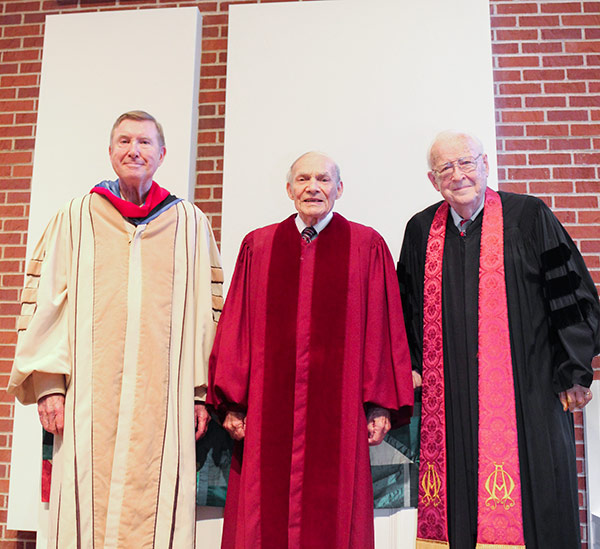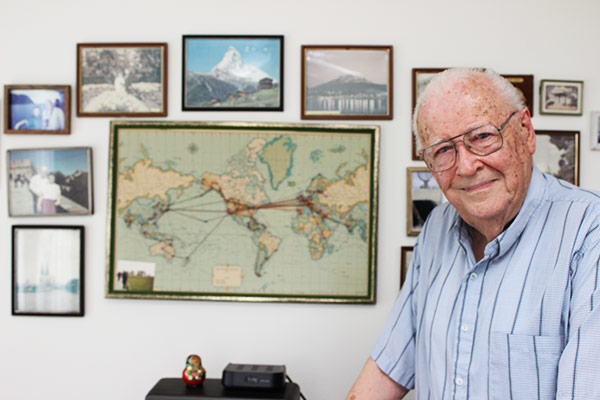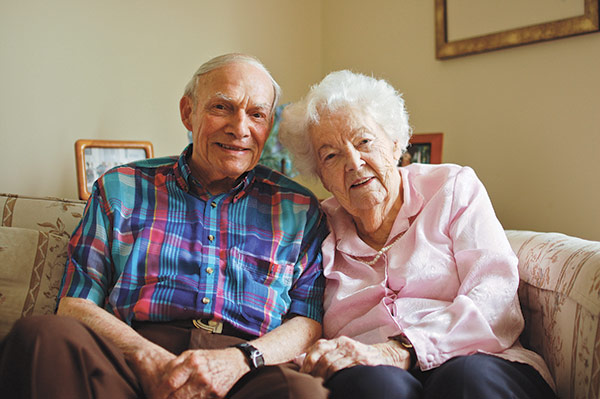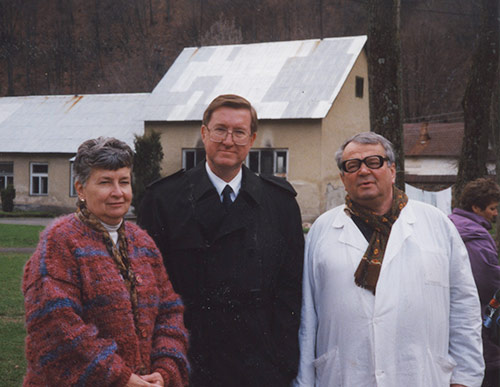
There are three wise men who currently live at Kroft Commons, the residential cottages located at Chapel Hill Community in Canal Fulton, Ohio. They share much in common. They’re all retired United Church of Christ clergy. They all have a connection with Heidelberg University in Tiffin, Ohio. They’ve all served in significant leadership roles on the Board of Directors of United Church Homes.
Their shared experiences go on and on, as do the gifts they’ve shared with others.
Few who know any one of them (or all three) would debate they’re wise—for Rev. Dr. Paul Kiewit, Rev. Glenn Royer and Rev. Dr. Ralph Quellhorst have clearly demonstrated wisdom time and again over their long careers. Yet for all their commonality, it’s what each did individually that makes their life stories compelling.
“Pastor, Where is Your Faith?”
With a booming voice and the confidence honed by 70-plus years preaching from the pulpit, Rev. Dr. Paul Kiewit is an accomplished story-teller. When he speaks, people listen. It’s impossible not to lean forward, sit on a seat’s edge and focus intently. He’s that good.
Yet should you hear him talk about the origins and early history of Hope Homes, Inc., you cannot escape the notion that it’s someone else who’s telling the story. Rev. Kiewit will cut to the chase, and tell you it’s God who’s the author of this story—always was, always is, always will be. Like the UCC proclaims, “God is still speaking.” Rev. Kiewit is definitely listening.
 In 1963, one of his parishioners, Margaret Leiphart, met with Rev. Kiewit to share an idea that she was 100% certain had to take place. Mrs. Leiphart was the mother of an adult son, Bobby, who was developmentally disabled, and she worried about who would care for him should she get sick or after she died. That’s why she approached Dr. Kiewit and invited him to spearhead efforts to launch a new ministry to make a place for Bobby. At the end of their conversation, she opened her purse, took out a bill, placed it on the desk, and said, “Here’s $5 to get it started.”
In 1963, one of his parishioners, Margaret Leiphart, met with Rev. Kiewit to share an idea that she was 100% certain had to take place. Mrs. Leiphart was the mother of an adult son, Bobby, who was developmentally disabled, and she worried about who would care for him should she get sick or after she died. That’s why she approached Dr. Kiewit and invited him to spearhead efforts to launch a new ministry to make a place for Bobby. At the end of their conversation, she opened her purse, took out a bill, placed it on the desk, and said, “Here’s $5 to get it started.”
As she left that day, she assured her pastor that she would continue praying for him, and told Rev. Kiewit that he was not alone. God would be helping him, every step of the way.
Rev. Kiewit had no way of knowing how true Mrs. Leiphart’s words would be.
Thus began what was, for many years, a one-man campaign to raise funds, pique interest and secure commitment to launch a ministry that could help Bobby. At every turn, Rev. Kiewit met with blank stares, good intentions, best wishes and passionate indifference. That’s not to say his efforts went completely unrewarded. After one year, he’d raised $25 (after receiving an additional $20 gift from Mrs. Leiphart). After five years, there was $300 in the account.
This was all Rev. Kiewit had to show for countless hours spent making calls, writing letters, campaigning, pleading for support and assistance from someone—anyone—who might get engaged. There were two constants in his quest: first, little or no success in raising funds; and second, intermittent reminders from Mrs. Leiphart that she was still fervently praying for him.
Finally, after five years of total, abject frustration, Rev. Kiewit concluded that enough was enough. He arranged to meet with Mrs. Leiphart to tell her the project just was not going to happen; that it was an impossible task; that the time had come to abandon Hope Homes and move on to something reasonable and realistic.
They met. He told her his thoughts. There was an awkward silence for a moment. Then Mrs. Leiphart shook her finger at Rev. Kiewit and uttered the words that he remembers today with such clarity, “Pastor, where is your faith?”
At the risk of ruining a great story, this exchange was just one of several key turning points. Obviously, the project’s course began to change, resulting in what is today a strong and viable ministry, based in the Akron suburb of Stow, providing care for about 250 adult residents in 22 homes. Hope Homes, Inc. is the kind of miracle that happens when a big dream, unceasing prayer, hard work and unblinking faith in God all combine to make something unbelievable come true.
It’s been said that faith untested does not qualify as faith. Just ask Rev. Kiewit. He will tell you such a story.
“This is heaven!”
 Ask Rev. Glenn Royer about the most memorable moment from his 50-year tenure as a UCC pastor, and he will tell you it’s move-in day whenever an UCH affordable senior community opens up.
Ask Rev. Glenn Royer about the most memorable moment from his 50-year tenure as a UCC pastor, and he will tell you it’s move-in day whenever an UCH affordable senior community opens up.
The air is abuzz with activity as friends, families and other interested parties gather to help residents move into a brand-new apartment—designed, built and equipped specifically to accommodate an independent senior’s lifestyle.
Reserved and humble, Rev. Royer breaks into a huge smile when he recalled a woman who moved into the first new community built by United Church Homes, Canal Village in Canal Winchester, in 1986. The woman was so thrilled and excited that she looked around her new home and exclaimed, “This is heaven!”
“I never forgot that,” said Rev. Royer.
Indeed, who could? Especially when you learn that Rev. Royer is not just an interested pastor who happened to be available to lend a helping hand on move-in day. Though he would no doubt shy away from such a broad statement, Rev. Royer is the principal reason why United Church Homes is so fully immersed in providing affordable senior housing to more than 2,500 individuals living in 58 communities in 13 states. He was the “founding father” of the organization’s affordable senior housing service line.
Rev. Royer was serving as pastor at David’s UCC in Canal Winchester, and was also on the Board of Directors for United Church Homes in the early 1980s when the organization made an acquisition that included two senior housing properties in northeast Ohio. The more he learned about these subsidized housing communities, the more Rev. Royer realized the need for a comparable ministry within his own congregation.
At the time, Canal Winchester was a rural town of 5,000 people located about 15 miles southeast of Columbus, Ohio. It was hardly a place where one would plant a thriving enterprise.
However, given the support exhibited by Rev. Phil Loucks, CEO of UCH at the time, Rev. Royer kept pursuing the project. Other interested parties included Bob Hart and Ruth Pifer, who are/were members at David’s UCC where Rev. Royer was the pastor. They became strong supporters of the affordable housing initiative and have remained so ever since. Rev. Royer recalls a far more detailed version of that first development, which included “storming City Hall” and persuading local citizens that residents would be fellow friends and families from Canal Winchester.
And so began what has become a major component of United Church Homes’ ministry.
Rev. Royer may have been pre-ordained to fulfill his role in UCH’s development of affordable senior housing. What he calls his “70-year love affair with United Church Homes” began in the 1940s when he and his new bride, Millie, would “load up their kids, garden produce, home-canned fruits and vegetables at Zion Church in North Canton, and deliver them (not the kids) twice a year to the residents of Fairhaven Community in Upper Sandusky.”
Twenty years later, in 1962, Rev. Royer and his family helped clear the land on the farm that would one day become Chapel Hill. His first pastorate was at St. Peter’s UCC in Apple Creek, where he introduced Ila Basler to Chapel Hill Community. Ila later bequeathed most of her property to Chapel Hill, a gift that bears her namesake as the Basler Community Center at Kroft Commons.
Rev. Royer and Millie have lived in their two-bedroom cottage at Kroft Commons since 2000. “This is home,” said Millie.
Yes it is, Millie, yes it is!
A Pastor Forged by Disaster
 Imagine being a new pastor, assigned to your first congregation in a small, rural town in Ohio. With a freshly minted theology degree in your pocket, a young wife and three-year-old twin daughters, you’re focused on your work. You’re making progress in helping parishioners see how God is still speaking to them.
Imagine being a new pastor, assigned to your first congregation in a small, rural town in Ohio. With a freshly minted theology degree in your pocket, a young wife and three-year-old twin daughters, you’re focused on your work. You’re making progress in helping parishioners see how God is still speaking to them.
Then on Palm Sunday, you and your wife head off to an early evening event. When you return home, you realize that nothing can ever be the same again—ever.
That’s what Rev. Dr. Ralph Quellhorst and his wife, Sue, experienced on April 11, 1965. For the young couple, Palm Sunday that year would always be the line of demarcation between the “before” and the “after.”
That’s because the Quellhorsts returned home to witness the devastation wrought by the Palm Sunday tornado that effectively destroyed Emmanuel UCC in Bluffton, Ohio, and leveled the adjacent parsonage, where they’d left the twins with a 16-year-old babysitter. For two agonizing hours, Ralph and Sue thought their daughters were dead, as surely no one could have survived in the rubble of wood, walls and wires. Miraculously, the babysitter had taken the girls to the basement just prior to the tornado splintering the house. They all survived.
The 1965 Palm Sunday tornado outbreak did not cause minor inconveniences to those directly impacted. It wreaked havoc. There was an outbreak of 47 tornadoes slicing across five states, leaving in its wake more than 270 dead and thousands of people injured. Death and destruction simply fell out of the darkness that night. There were seven fatalities in Bluffton, plus another six in Cairo a few miles away. The tornado shredded western Ohio, arriving as an F-4 twister with sustained winds in excess of 207 miles per hour. The funnel stayed on the ground for 18 miles.
“Considering how many church members were greatly affected by the tornado, and what had happened to my wife and daughters,” said Rev. Quellhorst, “I learned, in dramatic ways, what it means to be a pastor.”
His words are extraordinarily insightful, spoken nearly 50 years after the disaster by someone whose entire life since that fateful day has been spent building (and re-building) communities—on a local, state, national and international scale. His self-description of being a pastor is also ironic, considering that Emmanuel UCC in Bluffton was the only local church that he ever pastored.
Following the tornado, Rev. Quellhorst’s first task was to tend to the immediate needs of his congregation, as roughly 35% of his parishioners incurred direct hits, and to those of his wife and daughters, while focusing on the rebuilding of the Emmanuel community. Under his capable stewardship, the parsonage was dedicated just six months later, while the newly rebuilt church was dedicated one year after that.
Rev. Quellhorst’s career arc then took on an unending upward sweep—minister of the parish program for the Northwest Ohio Association; associate for leadership development for the Ohio Conference; associate for the office for church life and leadership for the national UCC headquarters in New York City; conference minister of the Indiana-Kentucky Conference in Indianapolis; culminating in being named conference minister of the Ohio Conference in Columbus.
Always present in his work were the triune elements of leadership, pastoring and building community—with the principal difference in each position being the nature of the group being shepherded, and the details of what needed to get done. As you’d expect from someone who witnessed firsthand the post-traumatic shock of disaster, he’s always been an advocate for anticipation and preparation.
His work in international circles took him and Sue to the four corners of the Earth: from Guatemala to India to Sri Lanka, from Germany to Hungary to Macedonia to Ukraine, where there’s an ecumenical chapel and a guest facility for a children’s orphanage named in his honor.
Wise Men, Wise Gifts
The gifts which the Revs. Kiewit, Royer and Quellhorst shared in their respective ministries touched the lives of literally thousands of people. Yet these are only a small sampling of the impact these wise men have had on others during their journey through life. It’s a privilege and an honor to have them living in retirement with Chapel Hill Community. Moreover, we are thankful and blessed to have had them as key leaders of United Church Homes.
Rev. Paul Kiewit documented his inspiring journey to establish Hope Homes, Inc. in “A dream, a prayer, and a $5 bill.” To read the entire story, click here.
